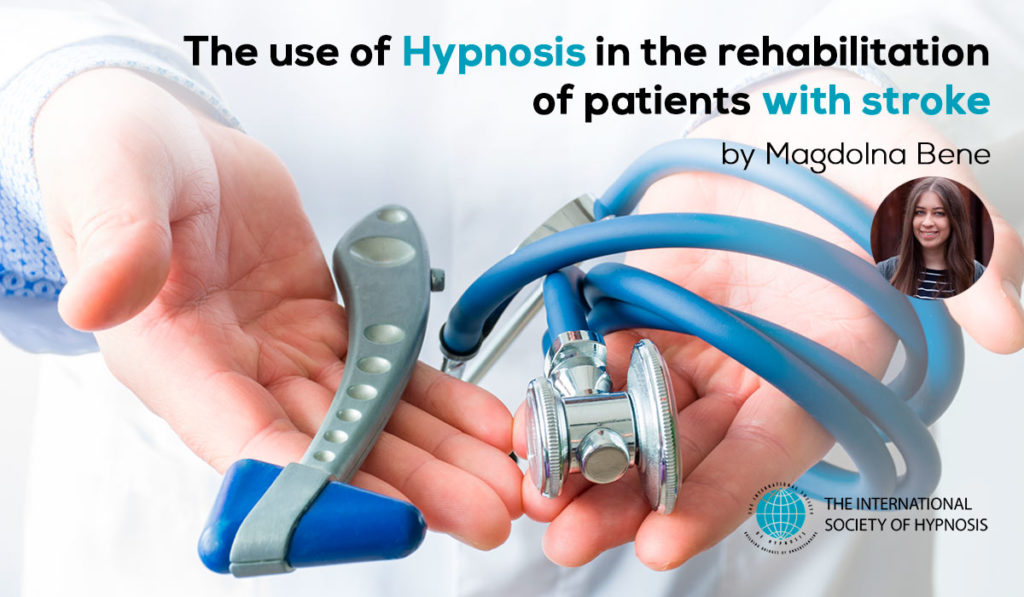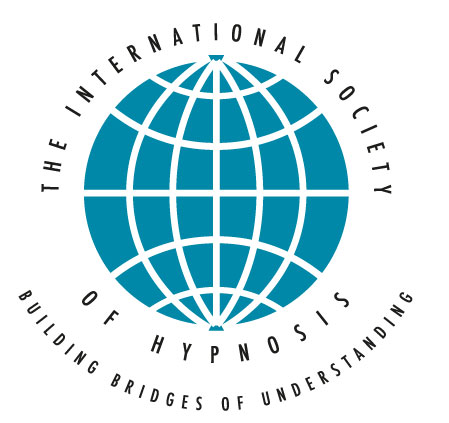

by Magdolna Bene
From the 1950’s there is evidence from case reports that the use of hypnotherapy can be appropriate in stroke rehabilitation (Shires, Peters & Krout, 1954). Crasilneck and Hall (1970) found that hypnotic intervention helps the rehabilitation of patients through reinforcing not only the functional ability, but also their motivation for recovery.
The typical technique for enhancing the motor functions in patients with stroke is the revivification or regression to a time of their life which is previous to the stroke event (Hammond, 1990; Kroger, 1977).
Holroyd’s (1992) research confirmed that formal hypnosis as well as waking suggestions are able to have an effect on the vasoconstriction and dilation. Appel (2003) successfully used hypnosis for improving the performance in balancing, coordinating and even in tasks that required fine motor skills.
An article from Indonesia (Rama & Napri, 2015) used SWOT analysis (Strengths, Weaknesses, Opportunities, Threats) to examine the use of hypnosis for patients with poststroke muscle tension. They summarized the effects of hypnotherapy using the techniques of progressive relaxation: it arouses the hormones that are responsible for the feeling of comfort, e.g. neuropeptides. This technique also targets the muscle activity, thus progressive relaxation can diminish muscle tension in people with stroke.
Diamond’s (2004) study focuses on 3 aspects of this topic. One is to evaluate the outcome of hypnosis on the activity of motor exercise done by stroke patients. Second is to find effects of the hypnotic sessions on motor cortex reorganization through fMRI. Finally, to examine the patient improvement over time. He included 6 people with a unilateral stroke which had happened a minimum 6 months prior the research, thus they could exclude spontaneous recovery. Before the hypnosis sessions, the subjects completed Mini Mental State Examination (Folstein, et al., 1975) (their score was at least 24), the Upper Extremity Motor Component of the FuglMeyer Test (Fugl-Meyer, et al., 1975) and the HIP (Speigel & Speigel, 1978) measure of their hypnotizability. After the fMRI scan was applied, the intervention with hypnosis began and it lasted for 4-5 sessions. The first three sessions involved hypnotic induction and motor performance test, the last two only contained measuring the performance for examining the strength of the potential changes. The hypnotic state related to sequential relaxation with mental imagery and the suggestions were designed to mentally rehearse and revivify their formal abilities. The motor function testing involved hand-grip testing and the fMRI scan after the 5 sessions.
The study describes the cases in detail. Each person received different suggestions related to their personal life or preference. At the end of every case study all of the patients mentioned improvement and five of the six also showed changes in their motor function.
The outcome of the first objective in this study is „decreases in reaction time and faster muscle contraction and relaxation rate” and „a reduction in spasticity, increases in range of motion for finger, wrist and elbow joints, and increased grip strength” (p. 41.). According to the results of the fMRI scans („increased extent of cortical activation; a lateralization shift from contralateral toward ipsilateral control; and significant increases in the extent of activation in bilateral sensorimotor cortex. These changes were not observed on the non-paretic hand.” (p. 41.)) the second objective was also fulfilled. The third aspect was successfully examined as well, the motor performance stayed at the same level after 2-3 weeks. These results suggest that people with stroke could have huge benefits regarding their motor performance by using hypnosis as a tool of recovery.
In the case study of Manganiello (1986) the subject was a 57-year-old musician with hemiplegic stroke from a cerebrovascular accident. He could not experience any feeling when touching the right side of his face and had problems with regulating his tongue. Spasticity was marked in the right arm and the muscles of the hand contracted persistently, including not being able to perform any digital movement with that hand. Furthermore, without an ambulator it was impossible for him to walk.
Manganiello implemented several hypnotic sessions with the patient with the goal of better recovery during and after the physical therapy. In the first session, hypnotic regression to the age of 10. The subject was given suggestions that he would be able to perform as he could when he was a child while remaining in trance.
For the first try he was helped by the author, but then he walked unsupported. Then the therapist suggested that both arms would act as normally. The patient squeezed the hand of the author with no difference in strength between the two arms.
For the second session, the patient brought improvement from his normal activities, but no precise movement could be shown (written numbers could not be read). Under hypnosis, he successfully accomplished the task, and with the same method, his speech got better. One week later, on the third session he reported that he was walking without an ambulator in any situations with more coordinated gait and also his speaking was more
understandable.
The next session he performed with total function of the leg, facial muscles, arm and hand. He was able to play on the saxophone in a waking condition for 5 minutes and 17 minutes in hypnotic state, thus facial muscle control was hugely improved. After 5 days, the last session was held, and the patient’s music performance was extended in both conditions. In addition, this case study shows how much impact could be achieved by hypnosis in rehabilitation with high motivation and strong rapport between the operator and the subject.
These scientific papers (both quantitative and qualitative) give a promising view of the usage of hypnosis in the clinical environment, especially in the rehabilitation of patients with stroke. It would be a considerable act if these proposals would be integrated into health centers along with the traditional medical and psychological care for helping these patients to reintegrate faster not only to the environment, but also to a better quality of their personal life.
 Magdolna Bene
Magdolna Bene
Eötvös Loránd University.
Faculty of Clinical and Health Psychology
bene.magdolna@student.elte.hu
Magdolna Bene is a Master student in psychology at Eötvös Loránd University in Budapest, Hungary.
Her specialization in the program is Clinical and Health Psychology and during her Erasmus+ semester in Leiden University she has started to have a deeper insight of the neuropsychological rehabilitation as well.
Thus, her main interests recently are the tools that hypnosis could give to this clinical field, such as mental rehearsal and hypnotic regression.
REFERENCES
- Appel, P. R. (2003, June). Clinical hypnosis in rehabilitation. In Seminars in Integrative Medicine (Vol. 1, No. 2, pp. 90-105). WB Saunders.
- Crasilneck, H. B., & Hall, J. A. (1970). The use of hypnosis in the rehabilitation of complicate vascular and post-traumatic neurological patients. International Journal of Clinical and Experimental Hypnosis, 18(3), 145-159.
- Diamond, S. (2004). Cognitive effects on the neurophysiology and biomechanics of stroke recovery (Doctoral dissertation, Harvard University).
- Folstein, M. F., Folstein, S. E., & McHugh, P. R. (1975). “Minimental state”: a practical method for grading the cognitive state of patients for the clinician. Journal of psychiatric research, 12(3), 189-198.
- Fugl-Meyer, A. R., Jääskö, L., Leyman, I., Olsson, S., & Steglind, S. (1975). The post-stroke hemiplegic patient. 1. a method for evaluation of physical performance. Scandinavian journal of rehabilitation medicine, 7(1), 13-31.
- Hammond, D. C. (Ed.). (1990). Handbook of hypnotic suggestions and metaphors. WW Norton & Company.
- Holroyd, J. (1992). Hypnosis as a methodology in psychological research. Contemporary hypnosis research, 201-226.
- Kroger, W. S. (1977). Clinical and Experimental Hypnosis in Medicine, Dentistry, and Psychology/Kroger WS–Philadelphia.
- Manganiello, A. J. (1986). Hypnotherapy in the rehabilitation of a stroke victim: A case study. American Journal of Clinical Hypnosis, 29(1), 64-68.
- Rama, T. A., & Napri, M. (2015). Hypnotherapy to Reduce PostStroke Muscle Tension in Indonesia. Scientific Journal of PPI-UKM, 2 (2), 53-56.
- Shires, E. B., Peters, J. J., & Krout, R. M. (1954). Hypnosis in neuromuscular re-education. United States Armed Forces medical journal, 5(10), 1519-1523.
- Spiegel, H., & Spiegel, D. (1978). Trance and treatment: Clinical uses of hypnosis. Basic Books.
